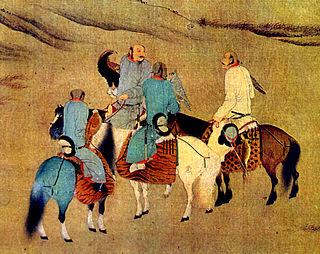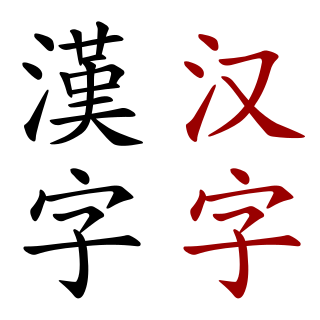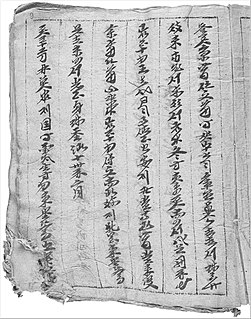
Many alphabets have been devised for the Mongolian language over the centuries, and from a variety of scripts. The oldest, called simply the Mongolian script, has been the predominant script during most of Mongolian history, and is still in active use today in the Inner Mongolia region of China and de facto use in Mongolia. It has in turn spawned several alphabets, either as attempts to fix its perceived shortcomings, or to allow the notation of other languages, such as Sanskrit and Tibetan. In the 20th century, Mongolia first switched to the Latin script, and then almost immediately replaced it with the Cyrillic script for compatibility with the Soviet Union, its political ally of the time. Mongol Chinese in Inner Mongolia and other parts of China, on the other hand, continue to use alphabets based on the traditional Mongolian script.

The Mongolic languages are a group of languages spoken in East-Central Asia, mostly in Mongolia and surrounding areas plus in Kalmykia and Buryatia. The best-known member of this language family, Mongolian, is the primary language of most of the residents of Mongolia and the Mongolian residents of Inner Mongolia, with an estimated 5.7+ million speakers.

The history of the Khitans dates back to the 4th century. The Khitan people dominated much of Mongolia and modern Manchuria by the 10th century, under the Liao dynasty, and eventually collapsed by 1125.

Balhae (698–926) was a multi-ethnic kingdom in Manchuria, the Korean peninsula and the Russian Far East. Balhae was established by refugees from the fallen Korean kingdom of Goguryeo and Tungusic Mohe tribes in 698, when the first king, Dae Joyeong, defeated the Wu Zhou dynasty at Tianmenling.
Khitan or Kitan, also known as Liao, is a now-extinct language once spoken in northeast Asia by the Khitan people. It was the official language of the Liao Empire (907–1125) and the Qara Khitai (1124–1218).

Shiwei were a Mongolic people that inhabited far-eastern Mongolia, northern Inner Mongolia, northern Manchuria and the area near the Okhotsk Sea beach. Records mentioning the Shiwei were recorded from the time of the Northern Wei (386-534) until the rise of the Mongols under Genghis Khan in 1206 when the name "Mongol" and "Tatar" were applied to all the Shiwei tribes.

The Eight Diagram Pole Fighter is a 1984 Hong Kong film by Shaw Brothers, directed by Lau Kar-leung and starring Gordon Liu and Alexander Fu in his final film appearance. It was released as The Invincible Pole Fighters outside of Hong Kong and Invincible Pole Fighter in North America.

The Khitan large script was one of two Khitan writing systems used for the now-extinct Khitan language. It was used during the 10th–12th centuries by the Khitan people, who had created the Liao Empire in north-eastern China. In addition to the large script, the Khitans simultaneously also used a functionally independent writing system known as the Khitan small script. Both Khitan scripts continued to be in use to some extent by the Jurchens for several decades after the fall of the Liao Dynasty, until the Jurchens fully switched to a script of their own. Examples of the scripts appeared most often on epitaphs and monuments, although other fragments sometimes surface.
An undeciphered writing system is a written form of language that is not currently understood.

The Khitan people were a nomadic people and proto-Mongols from Northeast Asia who, from the 4th century, inhabited an area corresponding to parts of modern Mongolia, Northeast China and the Russian Far East.

The Chinese family of scripts are writing systems descended from the Chinese Oracle Bone Script and used for a variety of languages in East Asia. They include logosyllabic systems such as the Chinese script itself, and adaptations to other languages, such as Kanji (Japanese), Hanja (Korean), Chữ nôm (Vietnamese) and Sawndip (Zhuang). More divergent are Tangut, Khitan large script, and its offspring Jurchen, as well as the Yi script and possibly Korean Hangul, which were inspired by Chinese although not directly descended from it. The partially deciphered Khitan small script may be another. In addition, various phonetic scripts descend from Chinese characters, of which the best known are the various kana syllabaries, the zhuyin semi-syllabary, nüshu, and some influence on hangul.

Jurchen script was the writing system used to write the Jurchen language, the language of the Jurchen people who created the Jin Empire in northeastern China in the 12th–13th centuries. It was derived from the Khitan script, which in turn was derived from Chinese. The script has only been decoded to a small extent.

The Khitan small script was one of two Khitan writing systems used for the now-extinct Khitan language. It was used during the 10th–12th century by the Khitan people, who had created the Liao Empire in north-eastern China. In addition to the small script, the Khitans simultaneously also used a functionally independent writing system known as the Khitan large script. Both Khitan scripts continued to be in use to some extent by the Jurchens for several decades after the fall of the Liao Dynasty, until the Jurchens fully switched to a script of their own. Examples of the scripts appeared most often on epitaphs and monuments, although other fragments sometimes surface.

The Liao dynasty, also known as the Liao Empire, officially the Great Liao, or the Khitan (Qidan) State, was an empire and imperial dynasty in East Asia that ruled from 916 to 1125 over present-day Northern and Northeast China, Mongolia and portions of the Russian Far East and North Korea. The empire was founded by Yelü Abaoji, Khagan of the Khitans around the time of the collapse of the Tang dynasty and was the first state to control all of Manchuria. Being ruled by the Khitan Yelü clan, the Liao dynasty is considered by historians to be a conquest dynasty of China.
Aisin-Gioro Ulhicun is a Chinese linguist of Manchu ethnicity who is known for her studies of the Manchu, Jurchen and Khitan languages and scripts. She is also known as a historian of the Liao and Jin dynasties. Her works include a grammar of Manchu (1983), a dictionary of Jurchen (2003), and a study of Khitan memorial inscriptions (2005), as well as various studies on the phonology and grammar of the Khitan language.

Nova N 176 is an undeciphered manuscript codex held at the Institute of Oriental Manuscripts (IOM) of the Russian Academy of Sciences in Saint Petersburg, Russia. The manuscript, of uncertain provenance, entered the collection of the IOM in 1954, and for more than fifty years nobody was able to identify with certainty what language or script the text of the manuscript was written in. It was only in 2010 that IOM researcher Viacheslav Zaytsev was able to demonstrate that the manuscript is written in the Khitan large script, one of two largely undeciphered writing systems used for the now-extinct Khitan language during the 10th–12th centuries by the Khitan people, who founded the Liao Empire in north-eastern China.
Juha Janhunen is a Finnish linguist whose wide interests include Uralic and Mongolic languages. Since 1994 he has been Professor in East Asian Studies at the University of Helsinki. He has done fieldwork on Samoyedic languages and on Khamnigan Mongol. More recently he has collaborated with Chinese scholar Wu Yingzhe to produce a critical edition of two newly discovered Liao Dynasty epitaphs written in the Khitan small script.












